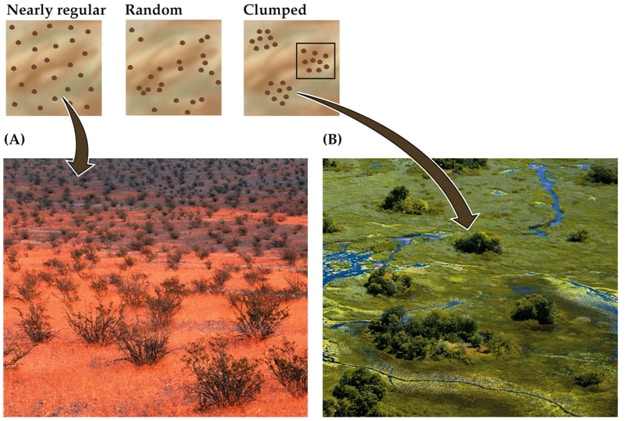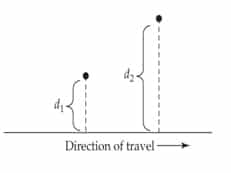- Distribution: Geographic area where individuals of a species occur.
- Abundance: Number of individuals in a given area.
- Ecologists try to understand what factors determine the distribution and abundance of species.
- Populations are dynamic—distribution and abundance can change over time and space.
- ***Understanding the factors that influence these dynamics helps us manage populations for harvest or conservation.
- Population: Group of interacting individuals of the same species living in a particular area.
- Interactions with populations include sexual reproduction and competition.
- Abundance can be reported as population size (# of individuals), or density (# of individuals per unit area).
- Sometimes the total area occupied by a population is not known.
- It is often difficult to know how far organisms or their gametes can travel.
- When the area isn’t fully known, an area is delimited based on best available knowledge of the species.
- Abundance can change over time and space. Some species vary more than others.
- Species vary in their ability to disperse. (In plants, dispersal occurs by seed movement. The distance moved can be very small. Other species, such as whales, can move thousands of kilometers in a year.)
- For some species, it’s hard to determine what an individual is.
- Aspen trees produce clones (genetically identical copies) when new plants grow from root buds. A grove of aspens may all be from the same individual.
- Other plants and animals can also form clones.
- Individuals can be defined as products of a single fertilization: The aspen grove would be a single genetic individual, or genet.
- If members of a genet are independent physiologically, each member is called a ramet.
- **** The distributions and abundances of organisms are limited by habitat suitability, historical factors, and dispersal.
Habitat Suitability
- Abiotic features: Moisture, temperature, pH, sunlight, nutrients, etc.
- Some species can tolerate broad ranges of physical conditions, others have narrow ranges.
Biotic features: Organisms are affected by herbivores, predators, competitors, parasites, and pathogens
- Abiotic and biotic features can interact to determine distribution and abundance.
- The real range is never as large as the potential range due to abiotic and biotic factors; species are often the weakest at the edge/ transition of their ranges
- Some species distributions depend on disturbance—events that kill or damage some individuals, creating opportunities for other individuals to grow and reproduce.
- Example: Some species persist only where there are periodic fires.
Historical Factors
- Evolutionary history and geologic events affect modern distribution of species.
- Example: Polar bears evolved from brown bears in the Arctic. They are not found in Antarctica because of an inability to disperse through tropical regions.
Dispersal
- Dispersal limitation can prevent species from reaching areas of suitable habitat.
- Example: The Hawaiian Islands have only one native mammal, the hoary bat, which was able to fly there. (human greatly increased the dispersal of species)
- Though a species may be able to live in area, doesn’t mean it will unless it can reach it; dispersal aids in this process
- Dispersal can also affect population density, and vice versa.
- Many species of aphids produce winged forms (capable of dispersing) in response to crowding.
- Geographic range—the entire geographic region over which a species is found.
- Many species have a patchy distribution of populations across their geographic range.
- Geographic range includes areas occupied during all life stages.
- Some species, such as monarch butterflies, migrate long distances between summer and winter habitats.
- For some species, it is difficult to find all the life stages and the ranges they inhabit.
- Abundance can vary throughout a species’ range
- For some species, population density is greatest in the center of the range.
- The dispersion of individuals within a population depends on the location of essential resources, competition, dispersal, and behavioral interactions.
- Dispersion: Spatial arrangement of individuals within a population:
- Regular—individuals are evenly spaced.(Competition results in regular dispersion)
- Random—individuals scattered randomly. (Highly unlikely; would need homogenous ranges)
- Clumped—the most common pattern. (due to patchy habitats and resources, herds)
In high quality territories, cooperative breeding occurs—young birds postpone breeding and instead help their parents raise more offspring. The high quality sites attract more birds and can result in clumped dispersions.
Population abundances and distributions can be estimated with area-based counts, distance methods, mark–recapture studies, and niche modeling.
Complete counts of individual organisms in a population are often difficult or impossible.
Several methods are used to estimate the actual abundance or absolute population size.
Relative population size: Number of individuals in one time period or place relative to the number in another.
- Estimates are based on data presumed to be related to absolute population size.
- Examples: Number of cougar tracks in a given area, or number of fish caught per unit of effort.
Area-based counts
- Used most often to estimate abundance of immobile organisms.
Quadrats: Sampling areas of specific size, such as 1 m2.
- Individuals are counted in several
- quadrats; the counts are averaged to estimate population size.
- Example:
- 40, 10, 70, 80, and 50 chinch bugs are counted in five 10 cm ´ 10 cm (0.01 m2) quadrats.
Distances of individuals from a line or point are converted into estimates of abundance.
Line transects:
Observer travels along line and counts individuals and their distance from the line.
Mark–recapture studies:
Used for mobile organisms.
A subset of individuals is captured and marked or tagged, then released.
At a later date, individuals are captured again, and the ratio of marked to unmarked individuals is used to estimate population size.
Example: 23 butterflies are captured and marked (M).
Later, 15 butterflies are captured (C), 4 of them marked (R for recaptured).
To estimate total population size (N):
Niche Modeling
- Ecological niche: Physical and biological conditions that a species needs to grow, survive, and reproduce.
- A niche model predicts a species’ distribution based on conditions at locations the species is known to occupy.





